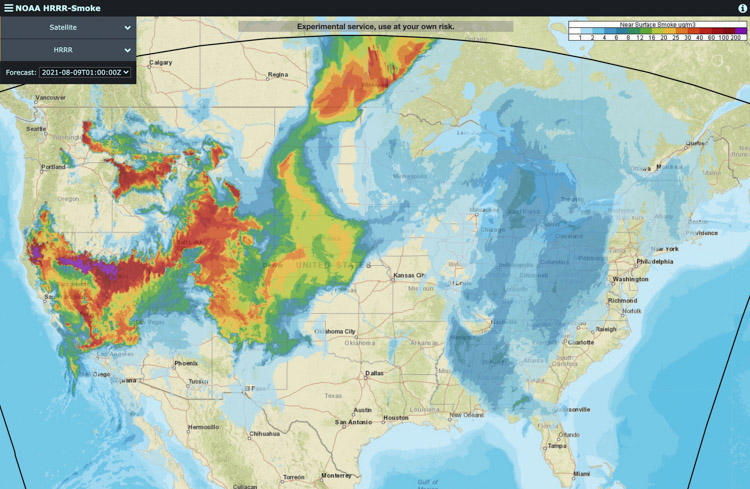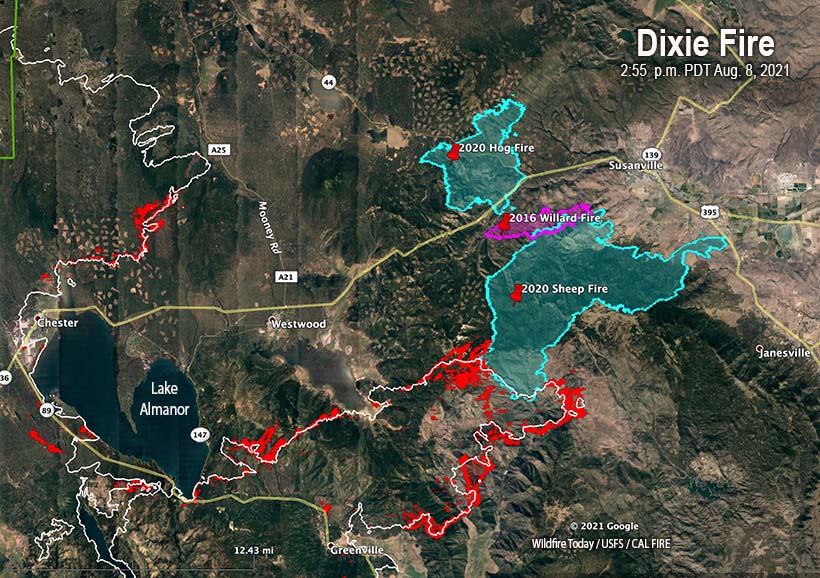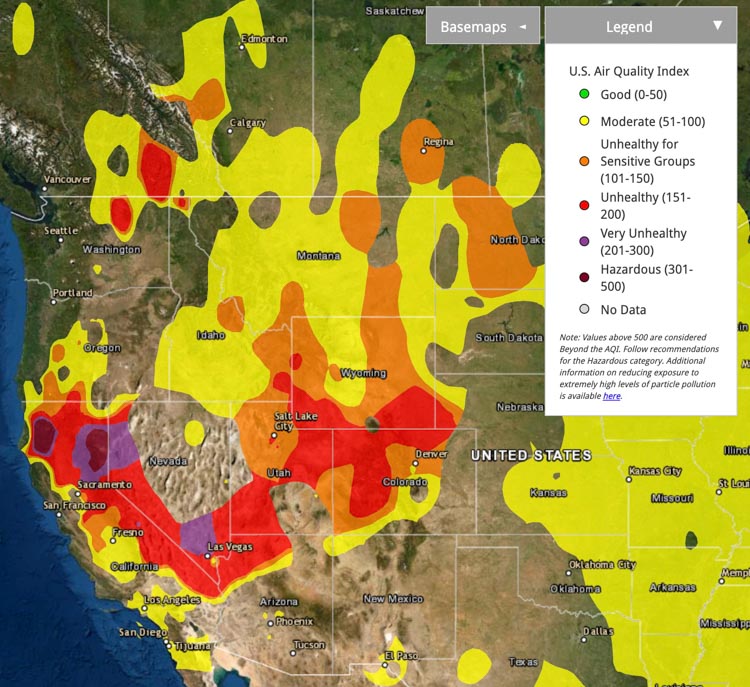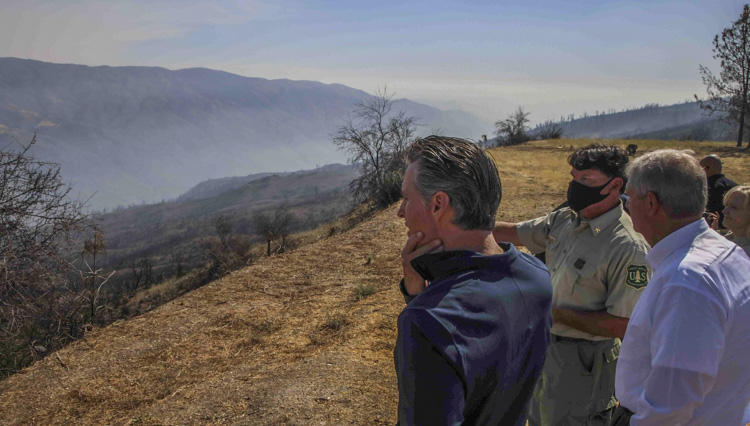
Wildfires in California, Oregon, Washington, Idaho, Montana, and Canada are creating smoke that is affecting air quality in most of the Western United States.

News and opinion about wildland fire
The Fly Fire merged with the Dixie Fire which also appears to have been started by the company’s equipment

12:58 p.m. PDT August 8, 2021
The Washington Post reported August 7 that a federal judge ordered PG&E to explain the utility company’s role in starting the Dixie and Fly Fires. The official causes of the fires are still under investigation, but U.S. District Judge William Alsup asked the company in an order issued late Friday to give details, by August 16, about the equipment and vegetation in the area where the fires started. Alsup oversees PG&E’s criminal probation for felony convictions stemming from the deadly 2010 San Bruno gas pipeline explosion.
On July 18 Pacific Gas and Electric (PG&E) told the California Public Utilities Commission (PUC) that on July 13 the company’s equipment may have ignited the Dixie Fire which at 453,000 acres has grown to become the second largest single fire in the recorded history of California.
To see all articles on Wildfire Today about the Dixie Fire, including the most recent, click HERE.
PG&E also said in another filing with the PUC on August 2 that its equipment may also be to blame for starting the Fly fire which eventually merged with the Dixie fire.
The Fly Fire was reported Thursday, July 22 near Keddie in Butterfly Valley about four miles north of Quincy. At first there was a question whether it was a spot fire from the Dixie Fire several miles away, or if it was unrelated. A fire behavior analysis determined the spot fire possibility was unlikely.
PG&E said that at about 5:01 p.m. on July 22 activity on SmartMeters, a line recloser, and alarms reported a problem, and the Gansner 1101 circuit was deenergized. Later PG&E assisted the U.S. Forest Service with moving and examining a tree that was resting on a conductor on the circuit.
6:53 p.m. PDT August 8, 2021

The wind across the Dixie Fire Sunday afternoon was stronger than it has been in several days. A weather station near Susanville recorded sustained 13 to 16 mph winds out of the southwest and west gusting at 19 to 24 mph. Combined with 12 percent relative humidity and very dry fuels the fire cranked up a head of steam and at 2:55 p.m. was mapped after spreading up to a mile east or northeast in the northeast section of the fire at the edge of the 2020 Sheep Fire.
There was little if any movement into the Sheep Fire footprint, but the Dixie Fire was active going around the corners. Presumably after the 2:55 p.m. flight, the limited spread around the edges of the Sheep Fire continued.
To see all articles on Wildfire Today about the Dixie Fire, including the most recent, click HERE.
At that time it was about 12 miles southwest of Susanville.
Sunday afternoon there was also additional fire spread northeast of Canyondam and northeast of Greenville. There was very limited fire movement in the northwest section of the fire seven miles northeast of Chester.
Maps are available showing the status of structures, and evacuations.

The weather forecast indicates conditions favorable for additional fire growth through this week, with warmer temperatures and southwesterly winds.
Continue reading “Somewhat slowed by smoke, Dixie Fire still spreads further east”
Suffered burns while attacking spot fire
7:31 p.m. PDT August 7, 2021

On Friday August 6, a handcrew was working on the south side of the McFarland Fire when a spot fire ignited ahead of them, the U.S. Forest Service said in a statement released August 7. While attacking the spot, six firefighters were exposed to some heat that resulted in first degree and minor second degree burns.
Amanda Munsey, one of the Information Officers at the fire, told Wildfire Today that the firefighters were examined by a Division Supervisor who happened to be a former Medical Unit Leader on the Incident Management Team. A helicopter was ordered to transport them to a hospital, Ms. Munsey said, but it was cancelled after it was determined it was not necessary. The six were taken by ground transportation to a hospital in Redding, California. The injuries did not meet the criteria for admittance to a Burn Center, so they were treated and released.
The firefighters will have two or three days off before they resume their duties.
The McFarland Fire is in northwest California on the south side of Highway 36, 5 miles west of Platina, California about an hour and 15 minute drive from Redding. It was one of many fires started from lightning around July 29 and has burned 30,000 acres since then.
The 44,000-acre Monument Fire is 21 miles to the northwest, 20 miles west of Weaverville, and on both sides of Highway 299.



Wildfires in Canada and the Western United States are having massive impacts on air quality in some locations, depending on the wind direction.
Above is the measured air quality at noon Pacific time.
Below are forecasts for wildland fire smoke, at 6 p.m. Saturday, and then Sunday.


“We have to have more boots on the ground”

On August 4 Governor Gavin Newsom, U.S. Agriculture Secretary Tom Vilsack, and new U.S. Forest Service Chief Randy Moore met at the burn scar of the 2020 August Complex of fires in Northern California to discuss state and federal collaboration on wildfire response and fuels management across the West.
During a press availability, Secretary Vilsack uttered words we don’t hear from Chiefs of the Forest Service, or certainly from Secretaries of Agriculture:
We are prepared to do a better job [of forest management] if we have the resources to be able to do this… Candidly, I think it’s fair to say over the generations and decades, we have tried to do this job on the cheap. We have tried to get by, a little here, a little there, with a little forest management here, a little fire suppression over here, but the reality is this has caught up to us.
We have to significantly beef up our capacity. We have to have more boots on the ground… And we have to make sure our firefighters are better compensated. Governor, that will happen.
We need to do a better job, and more, forest management to reduce the risk of catastrophic fire.
Governor Newsom said he has been exploring way to obtain more fire aviation resources, lamented that there are “only a few contracted DC-10s nationwide”, and said he was looking at how “to get the 747 back in our hands, and that’s been a challenge, that thing has been sold, so we’re still working to get some more aerial equipment.” (This statement is queued up in the video below.)
Secretary Vilsack said the Governor’s request for additional aviation resources, “… Came to my desk. One of the challenges we’re working on right now is making sure we get the Defense Department personnel necessary to fly the planes. So sometimes it’s not even the planes, it’s the pilots, the people who know how to fly these planes…I was given instructions to… make sure we have the people in the planes to fly them.”
The Secretary was most likely referring to the military Modular Airborne FireFighting Systems, MAFFS, which can be loaded into C-130 aircraft to temporarily serve as air tankers. They are the only military air tankers used on wildfires in the U.S. Each requires a seven-person crew, additional support personnel, and often a third conventional C-130 for every two MAFFS that are activated.
The Secretary’s comment could be the explanation for why only five of the eight MAFFS have been activated this year. On July 27, wondering if there was a specific reason why the remaining three were still parked, I asked US Forest Service spokesperson Stanton Florea if the three were available if needed. He replied on July 28, “There are 3 additional MAFFS-equipped C-130s that can be brought into service, if needed.”
As of today, August 6, there are still only five MAFFS working.
